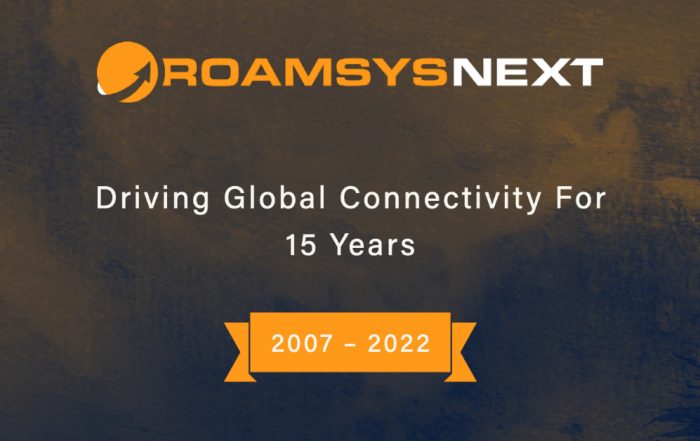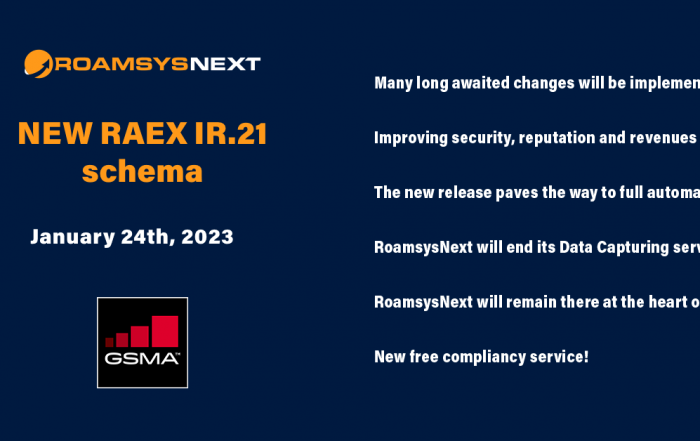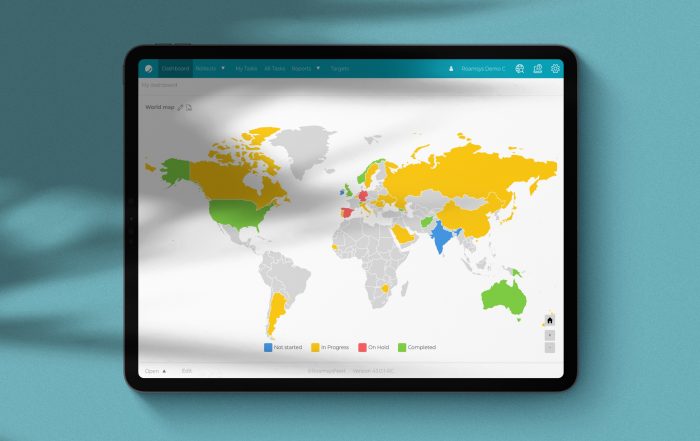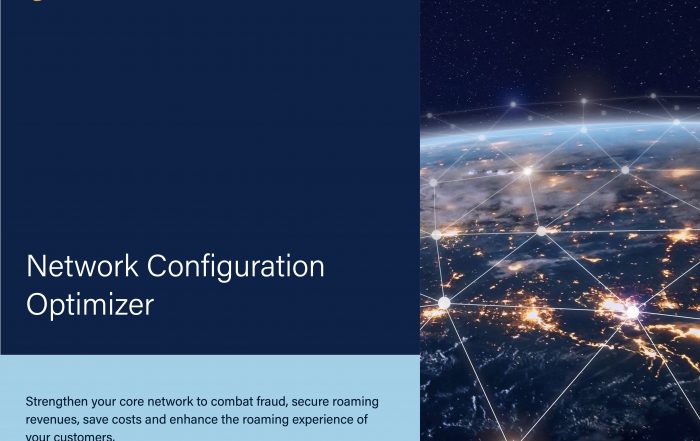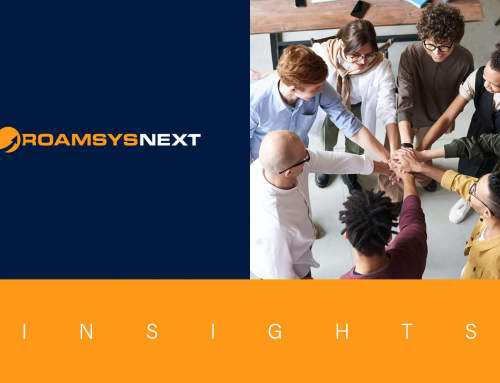
Priit Rohusaar
ROAMING SPECIALIST
Summary
With new technologies and standards mobile network configuration became a challenging task with an increasing number of network nodes to be configured. With the RAEX standard configuration data is delivered in a machine-readable format, but still needs validation to detect the relevant changes based on the commercially agreed roaming services. The RoamsysNext Network Configuration Optimizer is the perfect solution to make the shift from manual processing to more and more automated processing, with the option to move to full automation. This protects you from unexpected data in your networks with health checks pointing you directly to the configuration pain points to reach a new level of network security. It helps combating fraud, secures roaming revenues, saves costs and further enhances the roaming experience of your customers.
The Network Configuration Optimizer is one of the key products RoamsysNext offers to update your core network effortlessly and with better quality. You get all relevant data in one central place to speed up configuration and make the step to full automation based on your very own needs. It generates configuration files for all important network nodes and allows you to download or directly push generic and vendor-specific configuration files into your network. It strengthens your core network to combat fraud, secures roaming revenues, saves costs and further enhances the roaming experience of your customers. Even with connections to hundreds of roaming partners, network node updates, maintenance and troubleshooting can be done in a fraction of the time and with much better quality.

In RoamsysNext Insights our experts share their views on extensive industry topics and possible solutions we can offer.
Workflow optimization and full automation
With the mobile network evolution from 2G to 5G the number of core network elements that needs to be configured and maintained per each roaming partner network specifications has steadily increased. GPRS 2G, UMTS 3G, LTE 4G, NB-IoT, VoLTE, 5G etc. roaming services all need dedicated configurations in your core network based on partner network IR.21 document data. Number ranges, IP ranges, DNS IP addresses, MCC MNC, APN, Diameter EPC realm etc., must be implemented in your network for service launches and reviewed regularly based on updated partner network IR.21 documents.
Updated IR.21 data must be investigated to detect the relevant changes based on your commercially agreed roaming services. Once the changes have been detected and extracted, data needs to be converted into the right format for each updated core network node, based on your vendor requirements. Manual efforts to implement all technical changes in a timely manner has escalated with each added mobile network generation and ever-widening roaming coverage. Reviewing changes and knowing what needs to be configured for which commercial service is a daily challenge even for senior roaming coordinators.
Our tool uses complex, predefined but fully customizable automation rules, to keep all your systems in sync with the service changes and technical partner network updates without any human intervention. All possible scenarios can be described and stored in our rule engine, based on the accumulated knowledge of your roaming experts. So, in the future, your network will be updated smoothly even when senior colleagues are out of office.

Full automation without losing control
Service Openings
One main scenario for core network updates are service openings.
Let’s say your commercial team opens LTE 4G service with an existing GPRS partner and saves this change in your roaming footprint database. This automatically triggers NCO/IREG Toolbox service opening rules.
The tool already knows, based on individual pre-configured rules, what needs to be updated in your core network to launch LTE service with an existing data roaming partner. E.g., it creates vendor specific script files, based on pre-configured templates which include all the needed MML commands to modify existing PLMN profiles in Firewall and MME.

It automatically assigns those tasks to your technical colleagues/teams for implementation. Downloaded configurations can be directly uploaded without any manual adjustments in the data format. This saves your engineers time and improves the data quality. (Example workflow left)
NCO/IREG Toolbox supports end-2-end automation over direct API connection to your systems if you are willing to omit the only manual step in the process, reviewing of the script files, before they are loaded to your network.
Regular Updates
Besides service openings, you need to monitor IR.21 documents that are regularly updated. E.g., if your roaming partner makes any change in its IP core network, you must remove the old IP ranges and open new ranges, but only if you have data roaming services commercially live. Otherwise, IP section updates could be uploaded to your IR.21 database in the background, as nothing needs to be updated in you core network for the time being. (Example workflow left)
If any of the data roaming services (GPRS 2G, UMTS 3G or LTE 4G) is commercially live in your commercial roaming footprint, the tool automatically sees it as a relevant change and acts according to pre-configured configuration update rules. E.g., it could create script files to update the IP ranges in your BG Firewall & Billing System. (Example workflow right)


Priit Rohusaar joined RoamsysNext in 2016. With balanced skills between analytical and technical and hands on experience with the various parts of mobile networks he became the product owner for the Network Configuration Optimizer working with the configuration files and configuration audits of Ericsson, Huawei, Siemens, NSN, Fortinet, Cisco & other vendor switches. Before joining RoamsysNext, Priit worked in Luxembourg as Global IREG tester for Millicom International Cellular SA., a leading provider of cable, mobile and high-speed broadband services in Latin America and Africa. Before moving to Luxembourg in 2013, he was working as IREG engineer for Elisa Estonia.
“The team is a crucial asset”
It has been an exciting year for RoamsysNext. And as 2023 is coming to an end, we took the opportunity to talk with CEO Michael Grasmück about the past year, the growing team that becomes more and more international, and the comeback of an industry institution.
15 years of RoamsysNext – Driving Global Connectivity
RoamsysNext turns 15, so we talked with CEO Michael Grasmück about the anniversary, the early years, the move to Luxembourg and the future within the fast-developing roaming industry.
The new age of the IR.21 – Be ready for the full automation!
The new RAEX IR.21 schema will be released early 2023 with great changes coming that allow us to revolutionize the way we work with the IR.21 data.
Reporting at a glance: The RoamsysNext Dashboards
The RoamsysNext tools offer many reporting functionalities of which the dasboards play an important role. Learn more about using them in practice to identify bottlenecks, visualize your team's performance and bring a smile to your management's faces.
End-2-End-Automation with Network Configuration Optimizer
The RoamsysNext Network Configuration Optimizer is the perfect solution to make the shift from manual processing to more and more automated processing, with the option to move to full automation. Let's see how it works.
From Roamsys to RoamsysNext
Sixteen months ago, Roamsys relaunched and became RoamsysNext. Time to look back to a year we never expected to happen.
How to Stay Secure
What can MNOs do to stand up to the ever-growing tide of telecom fraud and protect their assets? Stay alert, use great tools, collaborate with other market players, and take the fight to the fraudsters.
Telecom Fraud Hurts
Telecom fraud is a rapidly growing area that has serious effects on national critical infrastructure (civil, healthcare, energy, agriculture...) and wider industrial processes.
The GSMA MISP – How Does it Help?
Malware information sharing and threat intelligence sharing has unbeatable benefits that make any caveats and challenges look small in comparison.
The Experts behind RoamsysNext Insights
RoamsysNext Insights has a growing fan base due to its substantial reports. With a wide variety of great information and exciting insights, they inspire beginners as well as professionals.
How to Treat 2G and 3G Closures without Becoming an Archivist?
As we are entering the era of 5G, legacy networks are in a state of flux and lose significance. This blog is about how the sunsetting of 2G and 3G networks will impact mobile communication.
How to Choose a Signaling Firewall Wisely
In times of global turbulences and increasing fraud attacks the decision for a sophisticated signaling firewall becomes more and more a priority. Some general considerations help to narrow down the choice.
Identity Fraud in Telecom
Identity fraud robs people of their virtual existence; it costs time, money and nerves. But there are countermeasures that help.
How to Tackle the Challenges in Combating Telecom Fraud
Telecom fraud can have dire effects on critical infrastructure and always causes painful loss of revenue. See how the industry's joint efforts tackle the challenges in combating telecom fraud.
Face the Breach: Rehearse an Emergency Before it Happens
In case of a breach, most companies are poorly prepared to take quick action. Have a look at some ideas on how to make the best of a difficult situation and save valuable time.
Working from Home during a Global Pandemic
Due to the broad introduction of remote working, businesses need to rethink their current cyber security measures and consider how they need to be adapted or further developed.
The Future of Roaming Trainings – An interview with Milja Hofman, CEO Roamingwise
Roamingwise is a well-known provider of roaming trainings, seminars and consultancy in a variety of international roaming topics. In our interview, CEO Milja Hofman reveals how she prepares professionals to drive the roaming world.
Historical Fraud Incidents and Lessons to be learned
In the course of history, no era is free from the practice of deception for personal benefit. Let’s have a look at what we can learn from historic fraud cases from ancient Greece to modern times.
Two-Factor Authentication rules!
For some time now, we have introduced 2FA and have contributed our share to provide more secure access to our tools. Norbert Becker, Head of Software Development, picks up the thread and provides engaging insights into his area of responsibility.
Introducing: The RoamsysNext Network Configuration Optimizer
Learn how the RoamsysNext Network Configuration Optimizer enables MNOs to switch safely to full automation and growing roaming revenues by providing effective and secure data management of all roaming related business information.
Introducing: The RoamsysNext Wholesale Roaming Manager
The RoamsysNext Wholesale Roaming Manager provides powerful collaboration and reporting tools for all roaming partner relationships by converging everything from service openings to the user’s roaming footprint, test SIM cards and tariffs, document and contact management.
Don’t fear the breach – three more ways to avoid configuration errors
Three ways to bliss: take bold measures to automate processes as much as you can, check your firewall’s security logs regularly and enforce centralized authentication mechanisms.
We’re in this together
In the second part of our interview with Alexandre De Oliveira, POST Luxembourg Cyberforce, he highlights major pain points in fraud detection and stresses the importance of global information sharing via the GSMA T-ISAC initiative.
Mastering today’s Fraud Landscape
Learn how Alexandre De Oliveira’s team at POST Luxembourg Cyberforce is mastering today’s fraud landscape with penetration tests, security assessments, the Telecom Intrusion Detection System (TIDS) and the Telecom Security Scanner (TSS).
How to avoid configuration errors
Hardening the network is a good way to get configuration errors under control. Introducing smart firewall rules and consistently updating these rules can be very time-consuming, but it’s a crucial measure to be taken.
From customer request to feature
In our newest “RoamsysNext Insights”, David Houstek and Adrian von Wendt elaborate on our customer focused production processes.
Making a Stand against Fraud
In an insightful interview, our CTO, Hendrik Hoehndorf, speaks about further GSMA initiatives on fraud detection and prevention such as the MISP (Malware Information Sharing Platform) and T-ISAC (Telecommunication Information Sharing and Analysis Centre).
Cyber security and fraud prevention – the GSMA approach
How does the GSMA approach cyber security, fraud detection and prevention? Look at the incredible useful tools and informations they provide with the Fraud and Security Group (FASG) and documents on best practice countermeasures.
How insecure GTP makes LTE and 5G networks vulnerable
GTP will still have an impact on 5G. Our tools can help to identify dubious requests faster, reduce reaction times and block incidents in a fraction of time.
How bad can it get? Signaling attacks strike the heart of each MNO
This blog is about how correct data is key to ensuring that mobile communication is of trustworthy origin, especially in case of signaling attacks. Notably, the roaming industry has to take action for data verification.
Grey Routes, Spam, Smish – funny words but nothing funny about SMS Fraud
SMS enjoys the reputation of being a safe channel for communication. But as any system, it is prone to abuse. We show you what needs to be done.
4 more Types of Telecom Voice Fraud MNOs are vulnerable to
Voice fraud is known as one of the top inter-carrier fraud cases, and in order to expose them, time and reliable data is crucial. This article shows that prevention is key to make sure that legitimate traffic is not obstructed.
Three Types of Telecom Voice Fraud that can destroy businesses
This issue shines a light on the variety of security breaches and fraud incidents: A cabinet of horrors.
Problems with telecom fraud? How big the issue really is. And how we can help
Fraud and security issues cause considerable problems within mobile network operators. But we are here to help.
Let’s talk about data quality
Most fraud and security issues are caused by misconfigured network nodes. This article shows, how RoamsysNext treats this problem on their quest for data quality.

